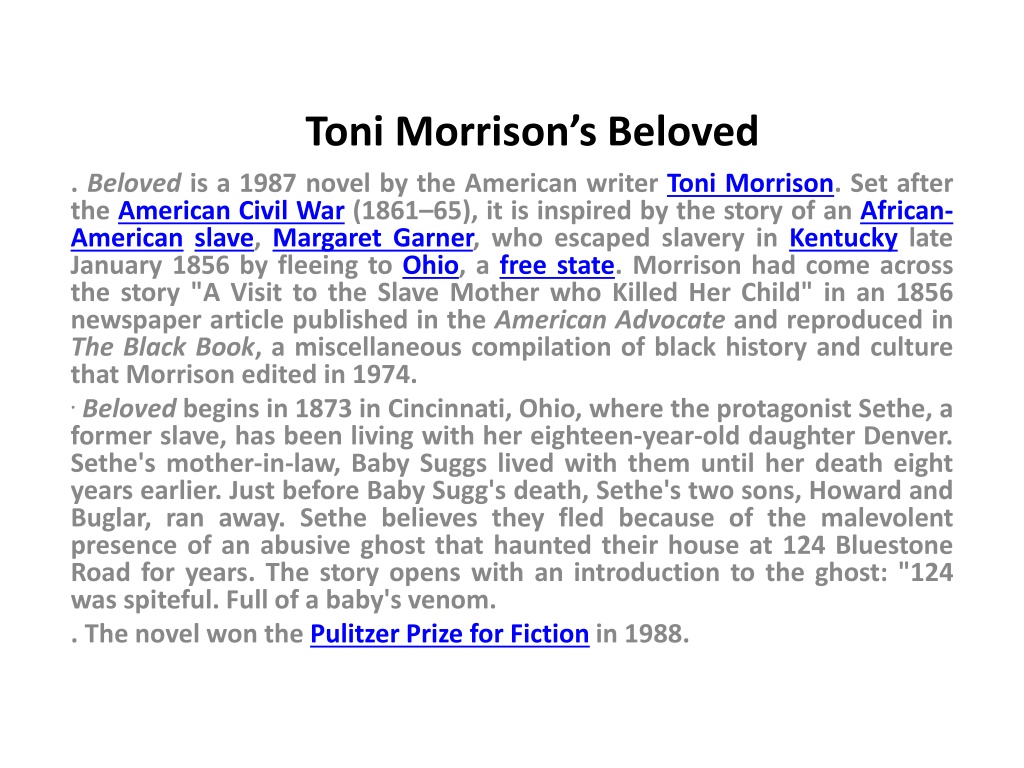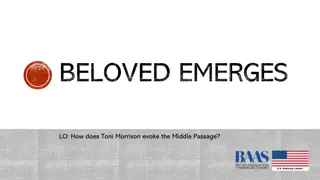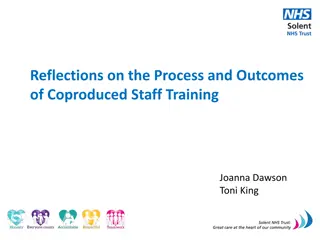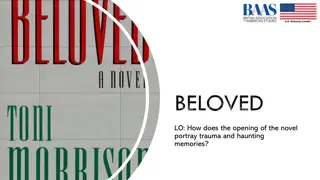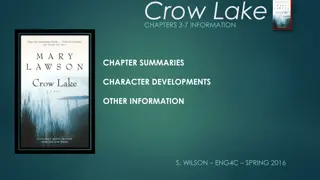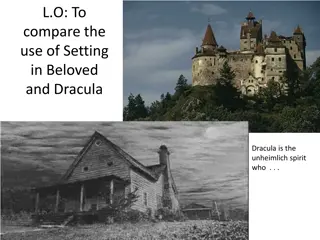Analysis of Toni Morrison's Beloved Novel
Toni Morrison's novel Beloved, set in post-Civil War America, follows the story of Sethe, a former slave haunted by the past. The narrative explores themes of trauma, oppression, and the struggle for freedom. Through complex characters and poignant storytelling, Morrison delves into the brutal realities of slavery and its lingering impact on individuals and society.
Download Presentation

Please find below an Image/Link to download the presentation.
The content on the website is provided AS IS for your information and personal use only. It may not be sold, licensed, or shared on other websites without obtaining consent from the author.If you encounter any issues during the download, it is possible that the publisher has removed the file from their server.
You are allowed to download the files provided on this website for personal or commercial use, subject to the condition that they are used lawfully. All files are the property of their respective owners.
The content on the website is provided AS IS for your information and personal use only. It may not be sold, licensed, or shared on other websites without obtaining consent from the author.
E N D
Presentation Transcript
Toni Morrisons Beloved . Beloved is a 1987 novel by the American writer Toni Morrison. Set after the American Civil War (1861 65), it is inspired by the story of an African- American slave, Margaret Garner, who escaped slavery in Kentucky late January 1856 by fleeing to Ohio, a free state. Morrison had come across the story "A Visit to the Slave Mother who Killed Her Child" in an 1856 newspaper article published in the American Advocate and reproduced in The Black Book, a miscellaneous compilation of black history and culture that Morrison edited in 1974. .Beloved begins in 1873 in Cincinnati, Ohio, where the protagonist Sethe, a former slave, has been living with her eighteen-year-old daughter Denver. Sethe's mother-in-law, Baby Suggs lived with them until her death eight years earlier. Just before Baby Sugg's death, Sethe's two sons, Howard and Buglar, ran away. Sethe believes they fled because of the malevolent presence of an abusive ghost that haunted their house at 124 Bluestone Road for years. The story opens with an introduction to the ghost: "124 was spiteful. Full of a baby's venom. . The novel won the Pulitzer Prize for Fiction in 1988.
Toni Morrisons Beloved Sethe, in her late thirties, is living with her 18-year-old daughter, Denver, in a house that the neighbors avoid because it is haunted. The time is the early 1870s, right after the first wrenching dislocations of the civil war and its aftermath. Sethe and Denver live in an uneasy truce with the ghost until the arrival of Paul D, one of Sethe's fellow slaves on her former plantation in Kentucky. Paul exorcises the ghost, but then a mysterious female stranger shows up. She is 20 years old and strangely unmarked - she has no lines in her palms, for example, and her feet and clothing show no signs of hard travelling. She calls herself "Beloved ", and Sethe and Denver are happy to take her in. Sethe, Denver, Paul D and every other character in the novel live simultaneously in their present and in their history - the chapters of the novel alternate between the two stories: that of the growing contest between Sethe and Beloved; and that of Sethe's life on the plantation, her escape, and the traumatic events that followed her crossing of the Ohio River and her appearance at the home of her mother-in-law, Baby Suggs. Sethe's former owner shows up with some officers to recapture the escapees, and Sethe attempts to kill her children. The two boys and the newborn survive, but she succeeds in slitting the throat of the two-year-old.
Toni Morrisons Beloved Morrison presents the bitter sequences of escaped slaves who most of them were hanged or mutilated. Thus, she intended to have two stories within one showing the brutality of being haunted by past oppression and by crime of murder. One of the reasons Beloved is a great novel is that it is equally full of sensations and of meaning. Morrison knows exactly what she wants to do and how to do it, and she exploits every aspect of her subject. The characters are complex. Both stories are dramatic but in contrasting ways, and the past and the present constantly modify each other. Morrison rejects realism, using a heightened style and a lyrical narrative method returning again and again to particular images and events. the reader is shocked at the sufferings of the black characters and the brutality of the whites, but knows at once that every torture and cruelty is not only plausible but also representative of many other horrors that go unmentioned in the novel and have gone unmentioned in American history. The novel seems more current and compelling. One reason for this is that racist attitudes in the United States change very slowly, but another is that Morrison is far more subtle in her exploration of her ideas. Morrison depicts every incident with such concrete expressiveness that the reader takes it in willingly as truth. She is also entirely matter-of-fact in her assertions - equally so about the presence and identity of the ghost as about the character flaws of the whites.
Toni Morrisons Beloved/ themes Slavery s distraction of Identity It expolres the physical, emotional, and spiritual devastation wrought by slavery, a devastation that continues to haunt those characters who are former slaves even in freedom. The most dangerous of slavery s effects is its negative impact on the former slaves senses of self, and the novel contains multiple examples of self-alienation. Paul D, for instance, is so alienated from himself that at one point he cannot tell whether the screaming he hears is his own or someone else s. Slaves were told they were subhuman and were traded as commodities whose worth could be expressed in dollars. Consequently, Paul D is very insecure about whether or not he could possibly be a real man, and he frequently wonders about his value as a person. Sethe, also, was treated as a subhuman. She once walked in on schoolteacher giving his pupils a lesson on her animal characteristics. She, too, seems to be alienated from herself and filled with self-loathing. Thus, she sees the best part of herself as her children. Yet her children also have volatile, unstable identities. Denver conflates her identity with Beloved s, and Beloved feels herself actually beginning to physically disintegrate. Slavery has also limited Baby Suggs s self- conception by shattering her family and denying her the opportunity to be a true wife, sister, daughter, or loving mother.
Toni Morrisons Beloved/ themes Baby Suggs s fatigue is spiritual, while Paul D s is emotional. While a slave, Paul D developed self-defeating coping strategies to protect him from the emotional pain he was forced to endure. Other slaves Jackson Till, Aunt Phyllis, and Halle went insane and thus suffered a complete loss of self. Sethe fears that she, too, will end her days in madness. Indeed, she does prove to be mad when she kills her own daughter. Yet Sethe s act of infanticide sheds the light on the forces of the institution of slavery: under slavery, a mother best expresses her love for her children by murdering them and thus protecting them from the more gradual destruction wrought by slavery. that slavery s negative consequences are not limited to the slaves. . slavery causes whites to become changed and altered . . . made . . . bloody, silly, worse than they ever wanted to be. The insidious effects of the institution affect not only the identities of its black victims but those of the whites who perpetrate (commit) it and the collective identity of Americans. Where slavery exists, everyone suffers a loss of humanity and compassion. For this reason, Morrison suggests that our nation s identity, like the novel s characters, must be healed. America s future depends on its understanding of the past: just as Sethe must come to terms with her past before she can secure a future with Denver and Paul D, before we can address slavery s legacy in the contemporary problems of racial discrimination and discord, we must confront the dark and hidden corners of our history.
Toni Morrisons Beloved/ themes The Importance of Community Solidarity Beloved demonstrates the extent to which individuals need the support of their communities in order to survive. Sethe first begins to develop her sense of self during her twenty-eight days of freedom, when she becomes a part of the community. Denver discovers herself and grows up when she leaves 124 and becomes a part of society. Paul D and his fellow prison inmates in Georgia prove able to escape only by working together. They are literally chained to one another, and Paul D recalls that if one lost, all lost. Cincinnati s black community plays a pivotal( vital) role in the events of 124. The community s failure to alert Sethe to schoolteacher s approach implicates (involve) it in the death of Sethe s daughter. the black community makes up for its past misbehavior by gathering at 124 to collectively exorcise Beloved. By driving Beloved away, the community secures Sethe s, and its own, release from the past. Morrison enhances the world of Beloved by investing it with a supernatural dimension. the characters in Beloved do not hesitate to believe in the supernatural status of these events. For them, poltergeists, premonitions, and hallucinations are ways of understanding the significance of the world around them.
Toni Morrisons Beloved/ theme As an infant, Denver drinks her sister s blood along with her mother s breast milk, which can be interpreted as an act of Communion that links Denver and Beloved and that highlights the sacrificial aspect of the baby s death. Sethe s act so horrifies schoolteacher that he leaves without taking her other children, allowing them to live in freedom. The baby s sacrificial death, like that of Christ, brings salvation.
